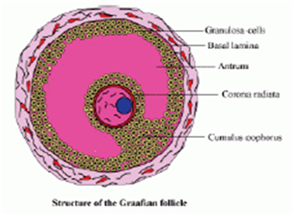 Short Answer Type
Short Answer Type(a) Where do the signals for parturition originate from in humans?
(b) Why is it important to feed the newborn babies on colostrums?Given reasons for the following:
(a) The human testes are located outside the abdominal cavity.
(b) Some organisms like honey-bees are called parthenogenetic animals.
 Long Answer Type
Long Answer TypeThe following is the illustration of the sequence of ovarian events “a†to “i†in a human female:
(a) Identify the figure that illustrates corpus luteum and name the pituitary hormone that influences its formation.
(b) Specify the endocrine function of corpus luteum. How dies it influence the uterus? Why is it essential?
(c) What is the difference between d and e?
(d) Draw a neat labeled sketch of Graafian follicle.
(a) Figure g illustrates corpus luteum. Rapid secretion of leutinizing hormone LH from pituitary gland induces the rupture of Graafian follicle and formation of corpus luteum.
(b) The corpus luteum secretes large amounts of progesterone and also estrogen which is essential for maintenance of the endometrium. Such an endometrium is necessary for implantation of the fertilised ovum and other events of pregnancy.
(c) Figure d is tertiary follicle which is characterised by a fluid filled cavity called antrum. The theca layer is organised into an inner theca interna and an outer theca externa. It is at this stage the primary oocyte within the tertiary follicle grows in size and completes its first meiotic division. It is an unequal division resulting in the formation of a large haploid secondary oocyte and a tiny first polar body. Figure e -is mature follicle or Graafian follicle. The secondary oocyte forms a new membrane called zona pellucida surrounding it.
(d) Diagram showing mature Graafian follicle
(a) Explain the menstrual phase in a human female. State the levels of ovarian and pituitary hormones during this phase.
(b) Why is follicular phase in the menstrual cycle also referred as a proliferative phase ? Explain.
(c) Explain the events that occur in a Graafian follicle at the time of ovulation and thereafter.
(d) Draw a graafian follicle and label antrum and secondary oocyte
 Short Answer Type
Short Answer TypeWhy is breast-feeding recommended during the initial period od an infant's growth? Give reasons.
 Long Answer Type
Long Answer Type(a) Briefly explain the events of fertilisation and implantation in an adult human female.
(b) Comment on the role of placenta as an endocrine gland.
 Short Answer Type
Short Answer Type